Defining Nuclear and Radiochemistry Expertise
The task of the committee was to examine demand for nuclear and radiochemistry expertise in the United States compared with the production (supply) of experts and to evaluate approaches for ensuring adequate availability of such expertise, including necessary science and technology training platforms for the next 20 years.1 In this chapter, the committee describes characteristics of nuclear chemistry and radiochemistry experts and how they have changed over time, assesses the level of research activity in nuclear and radiochemistry (indicating the health of the discipline for attracting students), and assesses supply and demand for expertise in this area. Detailed analyses in the areas of academic research, nuclear medicine, energy, environmental management, and security are provided in Chapters 4 through 7, respectively.
As pointed out in Chapter 1, because nuclear and radiochemistry is not a single distinct occupational category, area of certification, or disciplinary field, the lack of readily or consistently identifiable data presented challenges to analysis. The committee explains its thought process and methods to overcome these challenges in meeting its charge.
CHARACTERISTICS OF NUCLEAR AND RADIOCHEMISTRY EXPERTS
Fundamentally, nuclear and radiochemists are chemists who hold one or more degrees in chemistry and have taken additional specialized courses and conducted laboratory work in nuclear and radiochemistry, including the study of radioactive nuclei, nuclear processes, and nuclear applications in which chemical behavior is important. Their research interests reflect the breadth of the discipline’s applications—from nuclear energy to medical imaging, environmental chemistry, and nuclear security. They typically work in an organization’s chemistry department or division. Many
_______________
1 The committee’s complete Statement of Task is in Appendix A.
individuals who self-identify as nuclear and radiochemists are members of the American Chemical Society’s (ACS’s) Division of Nuclear Chemistry and Technology (DNCT), which is one of the 33 ACS specialty divisions. The committee considers this group to best represent, albeit not perfectly, the core of nuclear and radiochemistry experts.
Demographic and Publication Data
Demographic data for the DNCT membership provide some insights about the characteristics of nuclear and radiochemists and where they work. As of November 30, 2011, the DNCT (a.k.a. NUCL) had 1,015 members, mostly in the United States, about one quarter of whom are graduate and undergraduate students. Of the 78 percent of members who provided employment information, nearly half are in academic institutions, with the other half split between the government and the private sector (Kinard ACS, personal communication, February 22, 2011). ACS membership totals more than 164,000.
To get a sense of the professional affiliations of nuclear and radiochemists, the committee analyzed the e-mail addresses of U.S.-based authors of papers in three journals devoted to nuclear and radiochemistry research for 2006-2010 (Table 2-1). A significant fraction of articles in the journals were by government authors, especially for the Journal of Radioanalytical and Nuclear Chemistry.
Educational Background
The committee obtained educational information about nuclear and radiochemists from the DNCT website, which has in recent years served as a hub for tracking active nuclear and radiochemistry graduate programs as well as graduates of the Nuclear Chemistry Summer Schools. Starting from a list of 49 U.S. faculty member names last updated in 2008 (ACS 2008), the committee determined the thesis year and subject category for each faculty member using the ProQuest Dissertations and Theses (PQDT) database.2 The committee then identified 242 advisees of those faculty members, also using PQDT, and determined the subject term for each thesis. The committee considers the advisees of the 49 faculty members to be nuclear and radiochemists given that the advisees would have likely taken advanced coursework and conducted research in nuclear and radiochemistry during their graduate careers.
_______________
2 See Table E-1 in Appendix E for a full list of faculty names, institutions, and thesis terms.
TABLE 2-1 U.S. Share of Articles in Three Nuclear and Radiochemistry–Related Journals, 2006–2010
| Total number of articles | Total U.S. articles | E-mail address ending of corresponding author | |||||||||
| .gov | .edu | .com | Other* | ||||||||
| Radiochimica Acta | 567 | 74 | 28 | 28 | 2 | 16 | |||||
| Journal of Radioanalytical and Nuclear Chemistry | 2,294 | 393 | 198 | 114 | 39 | 42 | |||||
| Radiation Measurements | 1,539 | 181 | 29 | 55 | 25 | 72 | |||||
* includes: .org, .net, and others.
SOURCE: Committee-generated search of Web of Science database (Thomson Reuters).
TABLE 2-2 Count of Published Theses of U.S. Nuclear and Radiochemistry Faculty Advisors and their Advisees According to Subject Terms Identified through the ProQuest Dissertations and Theses Database
| Thesis Subject Term | Advisors | Advisees |
| With nuclear chemistry and other subject term(s) | 7 | 87 |
| Nuclear chemistry only | 21 | 31 |
| Without nuclear chemistry | 21 | 111 |
| TOTAL | 49 | 229 |
SOURCE: Committee-generated table from data obtained through the ProQuest Dissertations and Theses database. For more information, see Table E-1.
A comparison of the subject terms on the published theses of both advisors and advisees is shown in Table 2-2. What stands out in these data is that many of the advisors listed research areas and thesis subjects other than nuclear chemistry on their theses, as did their advisees, and the proportions for each group are quite different: nuclear chemistry was chosen much less often by the advisees. From these data, the committee concluded that the self-identification of nuclear and radiochemists varies and has changed over time, and that simply following the numbers of nuclear chemistry Ph.D.s reported by the National Science Foundation (NSF) Survey of Earned Doctorates (SED) through 2003 provides an incomplete picture of the numbers of experts in this subfield of chemistry.
Both the SED and PQDT data thus likely present an undercount of available nuclear experts in the field because Ph.D. researchers come from a wide range of backgrounds and do not always label their work as “nuclear chemistry.” For example, two committee members, Carolyn Anderson and Sue Clark, were identified in the DNCT faculty list (Appendix E; ACS 2008). Both are academic faculty members in nuclear and radiochemistry, but they have contrasting thesis subject terms: Anderson chose chemistry, analytical
chemistry, and nuclear chemistry, while Clark chose chemistry and environmental science—thus, Clark (and presumably her advisees) would not be among the theses counted by a “nuclear chemistry” subject term search. Nevertheless, the committee determined that a keyword search of “nuclear chemistry” in the PQDT database provides at least a baseline measure of the number of new Ph.D.s each year since 2003 to compare with the SED data.3
Once the committee performed its keyword search of the PQDT database for nuclear chemistry it compared the results to the number of Ph.D. degrees conferred in the field of nuclear chemistry according to the SED4 (although in 2004 nuclear chemistry was eliminated as a subfield in SED because of the low number of degrees reported in prior years, as discussed in Chapter 1; NSF 2010). A graph of SED and PQDT data since 1970 is shown in Figure 2-1. The committee chose to look back to 1970 because the number of nuclear chemistry Ph.D.s peaked in 1971 according to the SED.
The SED and PQDT series show similar patterns, generally declining from 1970 to 2000. However, there is a divergence between the two starting in the 1980s. One reason for this divergence is the difference between how the field of study in the PQDT and SED databases can be searched and how nuclear and radiochemists self-report their degree specialties. Specifically, while both PQDT and SED allow respondents to choose primary and secondary subjects for their field of study, only PQDT enables a search of all thesis subject terms collected (i.e., searches do not distinguish between primary and secondary field of study). Thus, the PDQT data include theses with nuclear chemistry as either a primary or secondary subject, whereas the SED data provide only a count of nuclear chemistry as the primary subject.
Moreover, as illustrated by the data in Table 2-2, students appear to be taking greater advantage of the opportunity to report more than one field of study in the PQDT form, which may help to explain the growing discrepancy between the PQDT and SED. For 2005–2010, when the SED no longer reported nuclear chemistry as a subfield, the PQDT shows a large increase in the number of Ph.D.s (Figure 2-1): by 2010, there were five times as many nuclear chemistry theses as there were nuclear chemistry degrees in 2003 (when the SED last reported such degrees).
_______________
3 The thesis submission form asks the author to choose a primary subject category, with the option of suggesting two additional categories. Nuclear chemistry (code 0738) is listed under mathematical and physical sciences. For more information see ProQuest (2011).
4 The SED is a record of the number of Ph.D.s in scientific and other specialties in the United States based on graduates self-reporting their field and subfield of study. It is administered annually to all Ph.D. degree recipients from U.S. institutions of higher education. It is conducted by the National Opinion Research Center (NORC 2011) and sponsored by the NSF and five other federal agencies; results are made available on the NSF website (www.nsf.gov/statistics/srvydoctorates/) [accessed June 30, 2012].
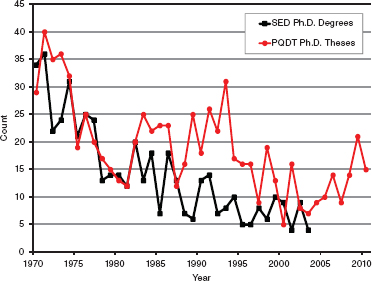
FIGURE 2-1 U.S.-granted Ph.D. degrees and dissertations in nuclear chemistry by year, 1970-2010, based on the National Science Foundation Survey of Earned Doctorates (SED) and the ProQuest Dissertation and Theses (PQDT) database. SED data (black squares) are based on selection of the term “nuclear chemistry” as the subfield of study on the questionnaire that was given to Ph.D. recipients for that year. PQDT data (red circles) are based on selection of the term “nuclear chemistry” as the subject area on the dissertation publication submission form.
SOURCE: NSF 2010; ProQuest 2011.
A similar recent growth in numbers of degrees has also been noted for nuclear engineering, based on a survey conducted by Oak Ridge Institute for Science and Education (Service 2011). Figure 2-2 shows the numbers of Ph.D. degrees in nuclear engineering generally declining since 1970, but with a significant increase since 2006.
Another characteristic important for nuclear chemistry and radiochemistry expertise is citizenship, due to the secure nature of much of the work in this field. Indeed, about 70 to 80 percent of nuclear chemistry Ph.D. degrees have been awarded to U.S. citizens,5 in contrast to chemistry as a whole, in which 50 percent of Ph.D. degrees went to U.S. citizens in 2006
_______________
5 Calculated from the restricted use version of the NSF Survey of Earned Doctorates. The use of NSF data does not imply NSF endorsement of the research methods or conclusions contained in this report.
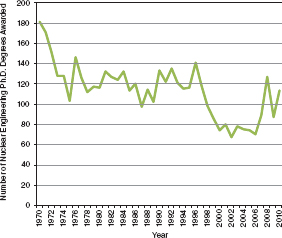
FIGURE 2-2 Trend in nuclear engineering Ph.D. degrees, 1970-2010.
NOTE: Includes programs with nuclear engineering majors and option programs in nuclear engineering equivalent to a major.
SOURCE: Jane Price, Oak Ridge Institute for Science and Education, Nuclear Engineering Academic Programs, personal communication, October 2011. (Also see Service 2011.)
(down from 85 percent in 1968; NSF 2011). Thus, drawing nuclear chemistry and radiochemistry expertise from the larger pool of chemistry degree recipients is challenged by the declining number of U.S. citizens earning Ph.D.s in chemistry.
RESEARCH ACTIVITY OF NUCLEAR AND RADIOCHEMISTS
Another measure of available expertise in nuclear and radiochemistry is the type of research activity, determined by keywords, reported in journals. The committee used the Web of Science database to search articles in scientific journals6 in order to determine both the number of articles in the field of nuclear and radiochemistry and the number of articles with an author located in the United States. The search was based on the keywords uranium, plutonium, technetium, fluorine-18 (used in PET imaging), and thorium, which were chosen to capture a sample of nuclear chemistry research across application areas. The committee acknowledges that the search does
_______________
6 The committee used Web of Science rather than other search engines such as Scopus because Web of Science identifies country of author.
not provide a comprehensive analysis of nuclear chemistry research and likely represents an undercount of the number of publications in this field.
Figure 2-3 shows that the number of articles by authors in the United States generally rose from the 1990s through 2010, whereas Figure 2-4 shows that the share of articles from U.S. authors for these keywords has gradually decreased since the early 1970s. However, this trend has been noted recently for U.S. articles in all science and engineering fields (Table 2-3) (NSB 2010, Tables 5-25, all S&E, and 5-29, chemistry), suggesting that the decreasing share of U.S. articles is not an indication that the United States is falling behind but rather that other countries are catching up.
The generally rising number of articles since the 1980s indicates that the field of nuclear chemistry remains active and expertise is available, despite decreases in the number of faculty and students during this same time period (Figure 2-1). The discussions and data in Chapters 3–7 show that researchers are pursuing many exciting topics in nuclear and radiochemistry.
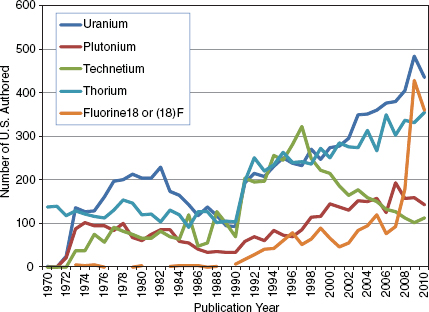
FIGURE 2-3 Number of U.S.-authored papers for selected nuclear and radiochemistry–related keywords, 1970-2010.
SOURCE: Web of Science keyword search, http://apps.webofknowledge.com, September 2011.
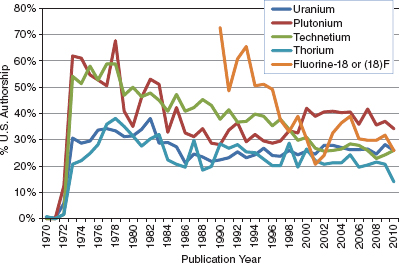
FIGURE 2-4 Percentage of U.S.-authored papers out of the total number of papers for selected keywords, 1970-2010.
SOURCE: Web of Science keyword search, http://apps.webofknowledge.com, September 2011.
TABLE 2-3 U.S.-Authored Articles for All Keyword Searches Related to Science and Engineering, Chemistry, and Nuclear and Radiochemistry
| 1995 | 2009 | ||||||||||
| Total Articles |
U.S.- Authored |
% U.S.- Authored |
Total Articles |
U.S.- Authored |
% U.S.- authored |
||||||
| Subject areas | |||||||||||
| All science and engineering | 564,645 | 193,337 | 34% | 788,347 | 208,600 | 26% | |||||
| Chemistry | 68,319 | 14,738 | 22% | 102,825 | 16,430 | 16% | |||||
| Nuclear and radiochemistry—relevant keywords | |||||||||||
| Uranium | 936 | 252 | 27% | 1,717 | 485 | 28% | |||||
| Plutonium | 250 | 74 | 30% | 432 | 160 | 37% | |||||
| Technetium | 628 | 245 | 39% | 422 | 103 | 24% | |||||
| Fluorine-18 | 184 | 88 | 48% | 785 | 231 | 29% | |||||
| Thorium | 264 | 60 | 23% | 332 | 69 | 21% | |||||
SOURCES: Subject areas: NSB 2012, Appendix Tables 5-27 (all S&E) and 5-31 (chemistry); keyword search of Thomson Reuters Web of Science, 2011; same as shown in Figures 2-3 and 2-4.
FUTURE SUPPLY AND DEMAND FOR NUCLEAR AND RADIOCHEMISTRY EXPERTISE
There are many uncertainties about what the demand will be for expertise in nuclear chemistry and radiochemistry over the next 20 years. For example, the areas of medicine and energy are driven significantly by commercial interests (as will be discussed in Chapters 4 and 5 respectively), while security and environmental management are driven more by government interests (Chapters 6 and 7, respectively).
As this committee was forming, there was a lot of discussion in the press about a possible nuclear renaissance that would expand development and use of nuclear energy around the world, which would in turn mean an increase in the need for skilled workers (many with nuclear chemistry and radiochemistry expertise). However, just days before the committee held its first meeting (March 16-17, 2011), the earthquake and tsunami hit Japan, severely damaging the Fukushima Daiichi nuclear power plant and surrounding areas and pretty much eliminating any plans for a nuclear renaissance in the United States in the near future. In the chapters that follow, the committee considers such scenarios and how they might affect future needs for nuclear chemistry and radiochemistry expertise.
Reports indicate that a sizable percentage of the nation’s experts in nuclear and radiochemistry at national laboratories and universities is nearing retirement (APS 2008, 2010; DSB 2008; Graham et al. 2008; Stimson 2009). For example, data collected from national laboratories by this committee (see Appendix F for description) show that there are currently about 1,000 career employees with nuclear and radiochemistry related skills, about 10% of whom are at or nearing retirement age (60+ years), and more than half of these have a Ph.D. (Figure 2-5).7 The projected demand for Ph.D.-level nuclear and radiochemistry experts (i.e., those with nuclear and radiochemistry degrees and those in jobs that involve nuclear and radiochemistry) at the national laboratories is estimated to be about 228 over the next 5 years (Table 2-4)8—almost 50 percent of the current total of Ph.D.’s.
In addition to needs at the national laboratories, another key factor that drives the demand for Ph.D.-level expertise—but is difficult to forecast—is research funding by the federal government, which translates into positions
_______________
7 Based on compilation of data obtained through personal communication from nine national laboratories: Argonne, Brookhaven, Idaho, Lawrence Berkeley, Lawrence Livermore, Los Alamos, Oak Ridge, Pacific Northwest, and Savannah River.
8 Based on compilation of data obtained through personal communication from seven national laboratories: Brookhaven, Idaho, Los Alamos, Pacific Northwest, Lawrence Livermore, Oak Ridge, Pacific Northwest, and Savannah River.
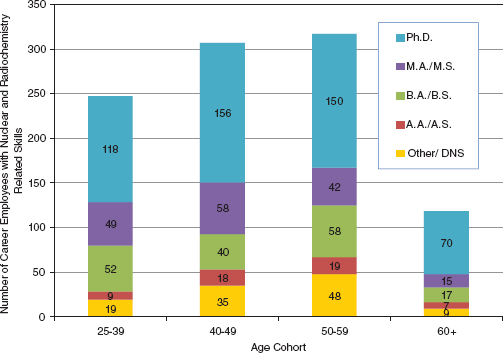
FIGURE 2-5 Estimated current number of national laboratory career employees with nuclear and radiochemistry–related skills according to degree.
NOTE: It is possible that the numbers presented here include a number of workers more closely related with fields other than nuclear and radiochemistry (e.g., nuclear physics and nuclear engineering).
SOURCE: Committee’s compilation of data from nine national laboratories: Argonne, Brookhaven, Idaho, Lawrence Berkeley, Lawrence Livermore, Los Alamos, Oak Ridge, Pacific Northwest, and Savannah River.
in government laboratories and at universities, including the training of new Ph.D.s and postdocs. One significant source of basic research funding specifically for nuclear and radiochemistry is the Heavy Element Chemistry program in DOE’s Office of Science, which has a favorable outlook in the near term (Table 2-5). DOE funding is also provided by the National Nuclear Security Administration (NNSA) and the Biological and Environmental Research, Nuclear Energy, Nuclear Physics, and Environmental Management program offices.
In addition, the Department of Homeland Security, National Institutes of Health, and National Science Foundation provide funding for nuclear and radiochemistry research. However, it is difficult to determine funding
TABLE 2-4 Projected Demand for Nuclear and Radiochemistry Expertise at National Laboratories
| Other/ DNS | A.A./A.S. | B.A./B.S. | M.A./M.S. | Ph.D. | |
| 1 year | 3 | 3 | 12 | 7 | 35 |
| 2-5 years | 32 | 17 | 58 | 52 | 193 |
| Total | 35 | 20 | 70 | 59 | 228 |
NOTES: Numbers based on projected terminations that will need to be replaced. It is possible that these numbers include a number of workers more closely related with fields other than nuclear and radiochemistry (e.g., nuclear physics and nuclear engineering).
SOURCE: Committee’s compilation of data obtained through personal communication from seven national laboratories: Brookhaven, Idaho, Lawrence Berkeley, Los Alamos, Oak Ridge, Pacific Northwest, and Savannah River. See Appendix F for details.
TABLE 2-5 Funding Provided by the Heavy Element Chemistry Program in the Department of Energy’s Office of Science (thousands of dollars)
| FY 2005 | FY 2006 | FY 2007 | FY 2008 | FY 2009a | FY 2010b | FY 2011c |
| $10,506 | $9,421 | $9,427 | $9,002 | $11,033 | $12,152 | $15,107 |
a Omnibus.
b Appropriations.
c Continuing Resolution.
SOURCE: Philip Wilk, DOE, personal communication, November 4, 2011.
levels specific to nuclear and radiochemistry in the budgets for the other programs and agencies. A detailed listing of funding programs is discussed in Chapter 9.
The identity of nuclear and radiochemistry experts varies and has changed over the past 20 years, as indicated by the committee’s survey of published thesis subject areas, the subjects of journal publications (as assessed by keywords), and the age and sector demographics of membership in the DNCT. They may identify their expertise as environmental science, analytical chemistry, medicine, or other areas rather than nuclear and radiochemistry.
As discussed in this chapter, the number of nuclear chemistry–related Ph.D.s theses has stabilized or increased slightly since 2004, as is also true of the related discipline of nuclear engineering. This trend may be the result of federal investments in both research and education in recent years (see Chapter 9). However, it is not clear that an adequate supply of nuclear and
radiochemistry experts will be maintained given increased demand (e.g., in sectors such as nuclear medicine and nuclear energy), possible shifts in public acceptance of nuclear energy, and the uncertainty that current funding levels will continue. Further, the diversity in educational backgrounds of nuclear and radiochemists, where and when they receive their training, and changes in how they identify their scientific specialties all make the accurate tracking of supply very challenging.
The next chapters explore the different subareas that require nuclear and radiochemistry expertise, and a summary of supply and demand data is presented in Chapter 8.
ACS (American Chemical Society). 2008. Universities Offering M.S. and Ph.D. Programs in Nuclear and Radiochemistry. American Chemical Society, Division of Nuclear Chemistry and Technology [online]. Available: http://spinner.cofc.edu/~nuclear/ACS%20NUCL%20and%20RADIOCHEM%20EDU%20US%20and%20CAN%20List11-12-08.pdf [accessed September 7, 2011].
APS (American Physical Society). 2008. Readiness of the U.S. Nuclear Workforce for 21st Century Challenges. A Report from the APS Panel on Public Affairs Committee on Energy and Environment. Washington [online]. Available: www.aps.org/policy/reports/popa-reports/upload/Nuclear-Readiness-Report-FINAL-2.pdf [accessed October 18, 2011].
APS. 2010. Technical Steps to Support Nuclear Arsenal Downsizing. Washington, DC: American Physical Society [online]. Available: www.aps.org/policy/reports/popa-reports/upload/nucleardownsizing.PDF [accessed October 19, 2011].
DSB (Defense Science Board). 2008. Report of the Defense Science Board Task on Nuclear Defense Skill. Office of the Under Secretary of Defense for Acquisition, Technology, and Logistics, Washington, DC [online]. Available: www.acq.osd.mil/dsb/reports/ADA487983.pdf [accessed October 18, 2011].
Graham, B., J. Talent, G. Allison, R. Cleveland, S. Rademaker, T. Roemer, W. Sherman, H. Sokolski, and R. Verma. 2008. World at Risk: The Report of the Commission on the Prevention of Weapons of Mass Destruction Proliferation and Terrorism, New York: Vintage Books.
NORC (National Opinion Research Center). 2011. Survey of Earned Doctorates (SED). NORC at University of Chicago [online]. Available: www.norc.org/Research/Projects/Pages/survey-of-earned-doctorates-(sed).aspx [accessed November 28, 2011].
NSB (National Science Board). 2010. Science and Engineering Indicators: 2010: Appendix Table. NSB 10-01. Arlington, VA: National Science Foundation [online]. Available: www.nsf.gov/statistics/seind10/pdf/at.pdf [accessed November 28, 2011].
NSB. 2012. Science and Engineering Indicators: 2012: Appendix Table. NSB 12-01A. Arlington, VA: National Science Foundation [online]. Available: http://www.nsf.gov/statistics/seind12/pdf/at.pdf [accessed March 6, 2012].
NSF (National Science Foundation. 2010. Doctorate Recipients from U.S. Universities: Data Table: 1999-2009. NSF 11-306. Arlington, VA: National Science Foundation [online]. Available: www.nsf.gov/statistics/nsf11306/data_table.cfm [accessed November 28, 2011].
NSF. 2011. Survey of Earned Doctorates, WebCASPAR Database [online] Year: All values; Citizenship (survey-specific): All values; Academic Discipline, Detailed (standardized): Chemistry; Number of Doctorate Recipients by Doctorate Institution (Sum); Citizenship (survey-specific). Available: https://webcaspar.nsf.gov/ [accessed November 1, 2011].
ProQuest. 2011. ProQuest Dissertations and Theses Database [online]. Available: www.proquest.com/en-US/catalogs/databases/detail/pqdt.shtml [accessed September 28, 2011].
Service, R. F. 2011. A field back in vogue. Science 331(5015):279.
Stimson (The Henry L. Stimson Center). 2009. Leveraging Science for Security: A Strategy for the Nuclear Weapons Laboratories in the 21st Century. Washington [online]. Available: www.stimson.org/images/uploads/research-pdfs/Leveraging_Science_for_Security_FINAL.pdf [accessed October 19, 2011].














